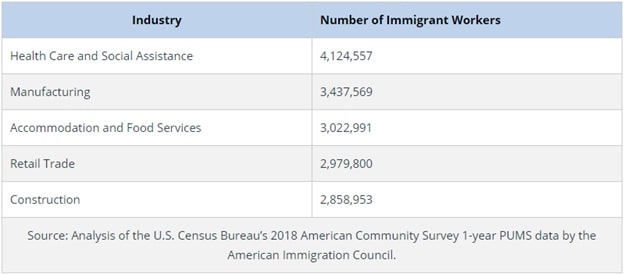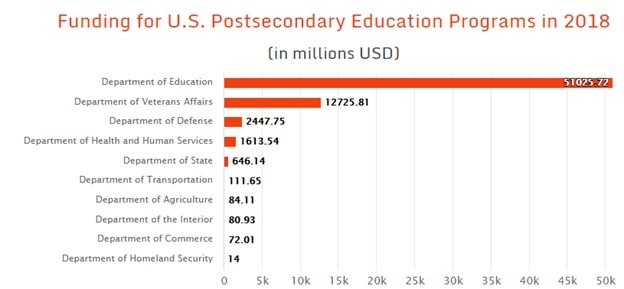- 22-Feb-2023 10:06 pm
- 54 Viewed
- 0 Comments
There are a large number of state and private universities and foreign nationals opting for higher education has grown tremendously, the US being the most preferred destination for higher education. We will look at some of the key aspects of higher education in the United States.
US Higher Education - Overview
- Levels of study in the higher education system
- US Higher education statistics
- Student immigrants opting for higher education in the US
- Student visas for higher education
- Cost of higher education in US
- Higher education in the 21st century
- Job market and H1B visa regulations
Higher Education in 21st Century
The emerging technology, politics, mergers, and closing had dramatic changes in the higher education system. The U.S. is recognized for its ability to incorporate new technologies pretty fast. Be it medicine, engineering, or technology you will always get more out of the US. The college enrollment in public and private universities in the US was approximately 19.6 million i.e from 1965-2018. And the number is growing due to increased awareness and economy. Refer to

The technology advancement gave a boost to online education in the 21century and also due to the ongoing pandemic Covid-19. Students, More than 6.3 million students in the US took at least one online course. With the far reach of the internet, many students are willing to enroll in online classes. Online classes are scheduled according to your convenience. This is also being cost-effective. The number of students enrolling online has been increasing constantly. In 2018 more than a hundred coding boot camps existed in US programs.
Higher Education Institutions in the United States
The higher education programs are designed for four years and then pass the finals which are by accumulating the hours of classroom study and the quality of work done in these courses. Universities providing four-year study either privately funded or by the federal aid given to the institutions. Private universities are largely dependent on tuition fees levied on the students. There are different types of colleges.
- Community colleges
- Liberal arts colleges
- For-profit colleges or Private colleges
- Religious universities and colleges
Among the top 200 universities and colleges in the world, 63 universities belonged to the US.
Various Levels of US Higher Education System
The higher education system in the United States consists of 3 levels. They are
- Undergraduate level
- Graduate-level
- Post-Graduate Level
Undergraduate Level or Bachelors Degree
To earn a bachelor's degree is designed for 4 years. Students have to study several subjects in the first two years such as literature, science, art, history, etc. The main focus is to gain general and basic knowledge about each subject before attaining specialization in a specific subject in the next 2 years. Majors in which one prefers to have a degree are chosen in 3r academic year. Students can change majors multiple times while studying graduation.
Graduate Level
Masters degree or Professional degree: The graduate program takes around 1-2 yrs to complete. Students pursuing a master's degree are required to work on a research paper called master thesis or master’s project as part of their program. A master's degree is crucial to attaining higher levels in career fields such as engineering, medicine, library science, etc.
Post-Graduate Level
Ph.D. and Research work: To earn a Ph.D. degree in the USA one requires to have a graduate degree. It takes 3-4yrs to complete a doctorate. Foreign students may require 5-6years to complete the same degree. The first two years students attend classes and seminars and 3rd year onwards students need to conduct independent research and have to write a thesis on the same. The thesis has to be original and should not have been published anywhere.
Student Immigrants in the USA
The United States has long been the most preferred destination for nationals and those looking to receive college education thanks to its vibrant economy. The number of students immigrating to the US has increased 87 percent in 1990 and 2000 and a further 38 percent between 2010 and 2019. The globalization of education and the economy are the major cause for the rise of student immigrants who want to pursue higher education. Refer to the below URL:

The entrance tests are required for entering a graduate program in the USA. Such as GRE for master’s program, LSAT for Law courses, and GMAT for MBA programs. Also, foreign students from some countries are only permitted to study at the graduate level after completing the required level in their home country. Additionally, international students might need 5-6 years to complete the doctorate compared to the US nationals or natives.
Student visas for Higher Education
The US colleges and universities have undergone multiple changes with changes in the federal administration. Sometimes the rules were tightened or loosened by the federal administration. The different types of American Student Visas are F-1 student visa, M-1 student visa, J-1 student visa.
F-1 Visa
This visa is issued for academic studies which are in the English language. F1 visas are the most common form of international student visas. They are a full-time student at a recognized and accredited college, university, etc. F1 status allows for part-time on-campus employment (fewer than 20 hours per week). Students can opt for OPT (Optical Practical Training) for up to one year after completion of the academic program. They are expected to complete their studies by the expiration date of their I-20 form (Certificate of Eligibility for Nonimmigrant Student Status)
J1 Visa
It is issued to students who want to pursue optical practical training that may not be available in their home country. The J1 student visa allows similar employment and restrictions as F-1
M-1 Visa
These are issued for students attending non-academic or vocational school. M1 visa holders for technical and vocational programs are prohibited from working while they are studying the course. M-1 student applicants must have evidence of sufficient funds to bear all the tuition and living costs for the entire period of intended stay.
International Students contribute $45 billion to the US economy and support 458,290 jobs
Job Market & H1B Visa Regulations
U.S employment projections show greater demand for workers with high-level education and skills for the future. Immigrants make up an important source of these higher-educated workers. Immigrants make up a significant number of the U.S workforce in various industries, accounting for over a third of all farming, fishing, and forestry workers. The highest number of immigrants work in the health and social service industry. An H1B visa is one of the most common and popular ways to work in the US. The visa must be applied by the employer on behalf of a specialist employee. This visa is granted to specialists where they hold a bachelor's degree from various fields like IT, finance, architecture, and medicine, etc.
Industry wise Immigrant Workers List

U.S employment projections show greater demand for workers with high-level education and skills for the future. Immigrants make up a large share of these higher-educated workers. Immigrants make up a significant number of the U.S workforce in various industries, they constitute over a third of all farming, fishing, and forestry workers. The highest number of immigrants works in the health and social service
industry. An H1B visa is one of the most common and popular ways to work in the US. The visa must be applied by the employer on behalf of a specialist employee. This visa is granted to specialists where they hold a bachelor's degree from various fields like IT, finance, architecture, and medicine, etc.
H1B VISA is the competitive visa to apply. There is huge demand from US employers applying for the visa and it is the route to the green card that makes it even more popular. The laws regarding H1B are changing with every administration.
H1B Visa Benefits
Applicants with H1B have many benefits are:
- Live and work in the US
- Extend stay in the US
- Can change employers during H1B tenure
- Dependents like spouses and children (aged under 12) are allowed
- You need a minimum score of 12 points for eligibility of F1.
- The Standard H1B filing fee currently is $555.
The other visas are H4, L-1A, L2, and R1 visa
H4 VISA is a non-immigrant dependent visa. It does not offer you permanent residency but the right to live, study and work in the US. Spouses of the H1B are eligible and children under the age of 21 whose parents are H1 visa holders.
- Privileges for H4 Visa
- Can get driver’s license
- Opportunities to study in the US
- Qualify for financial services like banking and H4 visa loan
L-1A VISA is issued for foreign directors or higher-level officials being transferred to US offices of their company. International businesses that do not have offices in the US are also eligible. L-1B is for staff with advanced skills who migrate to the US for a five year period.
L2 VISAs are also known as L1 dependent visas and are granted to spouses or dependents of L1. It is a non-immigrant visa. They can also change their visa status to F1, H1, B1/B2, and L1.
R1 VISA is specially issued for religious workers in the US. It is short term visa.College and Employment
The US employment market is huge, diverse and is always in need of skilled workers. Students after completing their college education and degree have higher chances of getting employed with earning potential being high. The college graduates have a potential of earning more than a million in lifetime. According to data from the college board from the US census board as of 2018, 83?chelor degree holders were employed compared to 68.8% of high school diploma holders. And only 1.8% of bachelors degrees were unemployed. In 2019 average annual earnings of US college graduates was 45,000$.

Conclusion
Thus Higher education of the US is diverse, robust and in line with changing global education trends and requirements. It’s one of the most sought after destinations for international students. It’s vibrant economy also plays a major part for increased international student immigrants to the country.
Top Ten Universities with most number of college admission applicants
- University of California, Los Angeles
- University of California, San Diego
- University of California, Irvine
- University of California, Berkeley
- University of California, Santa Barbara
- University of California, Davis
- New York University
- California State University, Long Beach
- San Diego State University
- Boston University

Stay tuned to FolksIT to know about the education related technology and software technologies updates 24*7.













.jpg)







_12.jpg)




